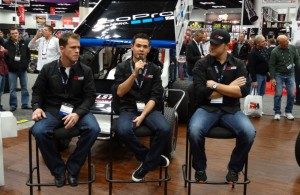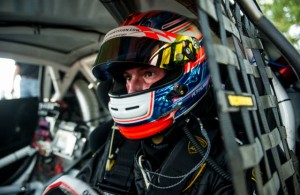Howdy, The Orbitor And Me
- Updated: June 3, 2008
The story of the Armstrong Mould Orbiter is a bit confusing but here it is, the way I saw and lived it.
First, a small disclaimer, This story is compiled from my first hand technical experience working on the car, first hand information concerning the business and political situations of the car and bits and pieces of info gathered from various first hand participants in the project.
I was involved, only, in the American end of the project which included race prep and operation of the car and following a “years after the fact” discussion with an engineer who participated in the design and construction of the car at the UK end, a few new bits of the story tied up some loose ends and created a few new questions.
This is the story of the Orbiter as I saw it!
To do a complete story , I must go back to when Howdy Holmes became involved with the team since he was one of the central characters in the “Orbiter” story.
In early ’79, Sherman Armstrong came over to the race shop and called a team meeting. He asked if anyone in the shop knew Howdy Holmes. I said that I had known Howdy since the eary 70s from our FF , Super Vee and Fatlantic days. Sherman asked if I thought he was any good. I said that he had won a lot in FF and SV and I always liked the guy.
Sherman said that Howdy had called him about driving one of our cars at INDY.
The deal was made and, because I was the only guy in the shop who knew him, I was assigned as his crew chief. We were given the old Wildcat-DGSOffy, which was a purty good Speedway car. We finished 7th and Howdy became the new “star” driver of the Armstrong team??? but with the Chaparral and the PC7 Penske, the future was obvious.
After a great ’79 season, Sherman wanted to get a ground effects car for 1980.
A clash of egos between Chaparral owner, Jim Hall and Chaparral designer, John Barnard over design credit resulted in Barnard leaving Chaparral. Sherman immediately signed Barnard to an “exclusive” contract to design a new Armstrong car which was to be constructed by B&S Fabrications in UK. Barnard was a partner in B&S. Well, It turns out that Barnard had also signed an “exclusive” contract to design F1 cars for McLaren.
This is where it gets murky, concerning the definition of exclusive contracts, etc. I’m not sure whether Barnard sub contracted the “design and build” to Robin Herd at March because of priorities at McLaren, whether Sherman agreed to the change of designers and builders. Or whether John Barnard had any input into the car at all. This part of the “Orbiter” story has never been clear to me.
Non the less, Robin Herd ended up with the “Armstrong project” but very little INDY experience and a short time frame.
The cars arrived at the Armstrong shop in March of 1980. After the ususal OH! And AWE! Session upon arrival of a new car, we realized that the cars were far from being finished and it was going to be a major struggle to get the cars ready for May, let alone any testing time. My ultimate impression of the car was that it was basically a giant F1 car, which seemed logical considering the background, knowledge and experience of Robin Herd.
Although my 1980 assignment was to be crew chief on the Huggers Lola driven by Jerry Sneva, I still put in many hours of finish work on the new Marches. March also sent engineer, Ian Reed and a March fabricator over to help.
The cars had the standard Hewland LG 500 gearbox and some of the very first “electronic ignition” Cosworth DFX engines.
This project was for Howdy Holmes from the start. No other driver was ever mentioned. I’m not sure if Howdy was invested in the car or if Sherman was just convinced that Howdy was “the man”.
As May approached, things took a bad turn when Howdy made a serious blunder by alienating the Armstrong crew. After this incident, the guys in the Armstrong shop that had worked so hard to help Howdy and the March guys, virtually abandoned the new car and went to work on the old Wildcat and the Lolas. I was very busy with the Huggers Lola and had very little further involvement or interest in the March.
May arrived and the Armstrong fleet went to work at the Speedway. We, quickly, got Jerry Sneva and the Huggers car up to speed. Bettenhausen was assigned to the Wildcat. Greg Leffler and Tom Bigelow were in the other Lolas.. Howdy, Paul Leffler and Ian Reed struggled all month with the untested car and could never get it going.
The rest of the Armstrong cars qualified and three of them finished in the top ten.
The post mortem on the March was that it created a lot of downforce and too much drag for Speedway racing which seemed like a logical conclusion considering that the car came out of an F1 shop and was designed and built by F1 guys.
The March cars went into hiding after Indy and never made another appearance during the rest of my days at Armstrong Mould. I left the team after the Pocono 500. Howdy took over one of the Lolas for some other 1980 races and I think, maybe, the March did make a couple of later season appearances on the road courses, for which it was much better suited.
The March drama continued with a late season offer to Sherman by George Bignotti to take the March out for a couple of test sessions to analyze to car. George was not doing this out the kindness of his heart. He had a plan to get a couple of “Sherman” financed test days with the car and meet with Robin Herd about designing a car that would be good at the Speedway. The plan worked and resulted in the March 81C Indy Car, which was the first of a very successful series of March Indy cars throughout the 80s.
There was much dissension between Sherman and Robin over the “monetary value” of the underperforming March Orbiter and the whole deal wound up in court.
I have no idea where the name, “Orbiter”, came from and I have no idea what ever happened to the “Orbiters” or where they are now. I know that Howdy flipped one over during the “Bignotti” test but how bad it was damaged, I don’t know?





![Porsche Fabcar crosses the finish line. [Robert Madara photo]](https://racingnation.com/wp-content/uploads/2023/11/FabcarFinish-108x70.jpeg)

![USF2000 Pro driver Lindsay Brewer. [Eddie LePine Photo]](https://racingnation.com/wp-content/uploads/2023/06/IMG_8825_2-108x70.jpg)